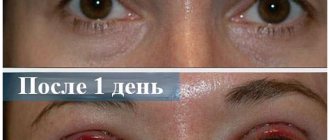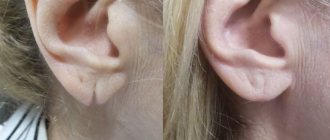Aesthetic voice surgery
is a set of surgical measures to correct the voice.
Glottoplasty can change the sound of the voice in men and women. Voice surgery is especially relevant for people in voice-speech professions, with existing problems with the vocal folds - polyps, cysts, granulomas, nodes, and paralysis of the folds. Men with high-pitched voices and women with rough-sounding voices seek glottoplasty. If a patient needs to restore his voice because it sounds too quiet, slurred, or becomes hoarse, vocal fold surgery also helps to cope with these problems. If the patient does not like his own voice, its sound can also be corrected through surgery on the vocal folds
.
Why is this necessary?
Of course, in order to correct your own timbre, regular exercises also help, but a fundamental change can only be achieved through surgery. Initially, intervention in the area of the vocal cords was considered as an opportunity to restore sound to those people who, for one reason or another, had lost it.
True, soon those patients who were already aged and wanted to gain a more youthful timbre became interested in the operation to change their voices, and then other categories of citizens joined them. This has now become a reality with the advent of background surgical ultra-precision technologies.
Previously, the larynx was considered a difficult area to perform operations due to its distance from the opening of the mouth. But now advanced microscopes, along with endoscopic and laryngoscopic instruments, solve this problem. Now we will find out when it is worth turning to the use of such medical manipulation.
Useful video
To see what exercises help relax your vocal cords, watch this video:
Similar articles
- Space lifting: before and after the procedure, what the face looks like
The space lifting procedure before and after gives a significant effect for problem areas of the face. It is important to know all the features of its implementation and recovery in order to get the maximum result. Read more - Vertical mastoplexy: features of…
An operation such as vertical mastopexy can help tighten sagging breasts. Unfortunately, it is not suitable for everyone, and complications are possible afterwards. However, many women took the chance and are satisfied with the before and after results. Read more
- Removal of a hernia of the eyelid (lower, upper)…
Often, removal of an eyelid hernia is necessary to maintain eye health, and not just for the sake of beauty. It is possible to do this with or without surgery. Transconjunctival removal of a hernia of the upper and lower eyelids is also considered one of the progressive methods. Read more
- Laser septoplasty: features of straightening...
An operation such as laser septoplasty is one of the most gentle operations for straightening the nasal septum. How is endoscopic septoplasty of the nasal septum performed? Read more
Indications for intervention
So, when is voice change surgery considered appropriate? A similar operation takes place in the following cases:
- If desired, change the pitch of your own voice in order to find the most attractive sound data.
- Presence of hoarse timbre.
- The presence of paralysis of the ligaments, as well as the occurrence of polyps and singing injuries on them.
- Damage to tissue, which reduces the aesthetic appeal of the sound timbre.
- The desire to correct the voice in order to be able to play as many notes as possible.
- Carrying out treatment of excess loads.
Voice surgery. Treatment method
A method for changing the pitch of the voice is called glottoplasty.
.
Injection glottoplasty is a surgical treatment to lower the pitch of the voice. The operation is performed under anesthesia. Biogel is injected into the patient's vocal folds. Microsurgical correction procedures are carried out using biopolymers that have disinfecting properties and are not capable of causing allergic reactions. Autologous fat, Teflon, and collagen are injected into the vocal folds. These materials are insoluble and are able to penetrate muscle tissue through the hole of the needle. Sometimes, to lower the tone of the voice, before introducing the biogel, a resection of a fragment of cartilage is performed, separating it from the larynx. After the operation, the folds are shortened and take on a flatter shape, and the voice becomes lower. After glottoplasty,
the vocal rest period lasts about 7-10 days. Biogel injections into the vocal folds, unlike Botox injections, do not dissolve over time. Injection glottoplasty can help lower your voice. Biogel injections into the vocal folds have an advantage over Botox injections. Botox injections do not provide permanent results. When too much Botox is injected, muscle relaxation occurs more than desired. The effect of Botox injection into the vocal folds is not permanent and goes away over time due to the appearance of new neuromuscular connections. Biogel does not dissolve and is not destroyed throughout a person’s life, which allows the effect to be consolidated for many years.
Preparation
In preparation for surgery to change the voice, it is necessary to diagnose the condition of the ligaments. The examination, as a rule, includes, in addition to interviewing the patient, the following manipulations:
- Inspecting the larynx using a mirror or frontal reflector.
- Using local anesthesia, the ligaments are examined through an optical flexible fiber that is inserted through the nose.
- Performing laryngoscopy. In this case, we are talking about a visual examination of the human larynx using a special mirror and endoscopes. The doctor pays attention to the shape, and in addition, to the color of the surface and the peculiarity of the neoplasm, if any.
- Carrying out stroboscopy. With its help, ligament movements are detected in combination with static areas and undesirable changes in vibrations. This is done thanks to light pulses directed at them. This procedure is necessary to identify dysfunction of the speech organs, scars or other formations.
Sometimes, for a more accurate diagnosis, a computed tomography scan is prescribed, a tumor biopsy is performed, and so on. How does vocal cord surgery work to change your voice? Read more about this.
Reasons for vocal cord surgery
Surgical manipulation of the vocal cords is possible for several reasons:
- due to scars formed due to injury or after surgery on the larynx and neighboring organs;
- for polyps, cysts, granulomas, nodes on them;
- if necessary, restore conversational abilities reduced after tumor removal;
- due to partial or complete paralysis of the ligaments;
- due to age-related changes in voice modulation;
- when it sounds rude to a woman;
- when men's voices are too high.
In most cases, the need for surgery is purely medical. The patient needs to restore his voice, as it sounds too quiet, slurred, and becomes hoarse. And after a long conversation, you feel tired, which also affects its quality. This makes communication difficult and can interfere with the performance of professional duties.
But surgery can also be done if you simply don’t like your own voice. Rejection of its sound does not harm your health, but it causes psychological discomfort, which is not far from somatic diseases.
We recommend reading about laser septoplasty. You will learn about the indications for surgery, the technique of performing it, the rehabilitation period, and possible undesirable consequences. And here is more information about rhinoplasty of the tip of the nose.
Carrying out the procedure
So, before the operation, the patient, as expected, is prescribed a diagnosis, within the framework of which it is necessary to identify the degree of risk. The voice pattern before and after the procedure is monitored by acoustic testing.
The mechanism of intervention itself is determined very individually, and it directly depends on the specific situation. The most popular types of surgery for modifying voice characteristics are transformation into a tenor baritone and, conversely, into an alto or soprano. Let's talk about this in more detail later.
Recovery of patients after intervention
Rehabilitation after surgery to correct voice disturbances should last at least three months. It usually includes several of the following conditions:
- The first two weeks or ten days, especially if the procedure was accompanied by the removal of any formation, you need to remain silent. In this case, you will have to communicate with others using gestures, using paper and pen, or other techniques.
- In the future, you also need to protect your voice by talking less. You should try to avoid whispering or talking in a raised voice. In both cases, the load on the ligaments increases.
- You cannot visit the bathhouse or swimming pool. During the recovery process, it is not advisable to breathe hot and humid air.
- It is necessary to carry out the procedures prescribed by the doctor. This can be irrigation, inhalation, blockade with medications, along with the infusion of special cocktails.
- Smoking, of course, is strictly prohibited at least during the entire postoperative period. It’s better to give up this bad habit completely, otherwise the problem with your voice will arise again.
- Among other things, alcohol should not be consumed. After one glass of wine, it seems that the timbre sounds better, because the elasticity of the ligaments increases slightly. But in fact, alcoholic drinks cause dryness.
- You should not eat hot or spicy food. It greatly irritates the mucous membranes, causes dryness, and so on.
- Some time after the operation, you need to contact a speech therapist. The specialist will certainly teach you conversation techniques that will reduce the stress on the ligaments.
Preventing problems
It is better to try to prevent changes in the voice, along with a sore throat, the appearance of a tumor on the ligaments, rather than treat and operate later. Problems can be avoided if:
- A person will learn to speak loudly without straining his ligaments, which can be facilitated by special speech techniques.
- It is necessary to avoid high loads on them in the first two hours after waking up.
- Hypothermia and overheating should not be allowed.
- All kinds of pathologies of the larynx and respiratory organs should be treated carefully, and at the same time completely.
- It is advisable to drink more fluids and gargle with soothing herbal infusions (chamomile is suitable along with calendula and sage).
- It is required to give up smoking and spicy food.
- You should try not to be in smoky and dusty rooms.
The cost of ligament surgery is currently quite high, so before making such a decision, it is necessary to try conservative methods. For example, breathing exercises will teach a person to control his own voice and slightly adjust its timbre.
You should definitely remember that speech errors, along with incorrect pronunciation of sounds, usually make an unpleasant impression on your interlocutors, so you also need to work on such problems, and first of all. When all this does not help, then surgery is the only way out. For some, the voice is especially important, so the cost of its correction for such patients, as a rule, does not matter.
Electronic larynx
The voice-forming apparatus, the electronic larynx, can be installed without surgery. It is a small device, similar to a microphone, which is applied to the neck and creates vibration instead of the larynx. Denis Smolyakov, who uses a voice-forming apparatus, names another disadvantage: the device needs to be charged every 1–2 weeks. If the electronic larynx suddenly runs out of power, you need to look for a battery.
Some patients refuse the electronic larynx, since speech with this device turns out to be monotonous and robotic. Denis’s wife, Yulia Filippova, says that she herself no longer notices that her husband speaks “somehow differently.” “It happens that people on the street pay attention to Denis. Well, he’ll look around, be surprised, and turn away, realizing that it’s not a robot behind him, and he’ll move on,” says Filippova.
Denis said the first word right away in the store, while purchasing the device. After a week, he began to slowly connect words into sentences, and within two months he had mastered the device perfectly and was talking on the phone. After some time, Smolyakov spoke from the podium, telling his patient story at a congress of oncology patients. “We have children, grandchildren, mother, sister, nieces - whether you like it or not, you will talk. Everyone asked his advice and wanted to talk to him. It’s more difficult for single people; a person speaks when there is someone to listen to him,” says Filippova.
The woman considers the electronic larynx to be the optimal method of voice restoration: there are no contraindications for it and there is no risk of complications. The state compensates for the purchase of a voice-producing apparatus once every five years. The amount it allocates is fixed - about 17 thousand rubles. This is the average cost of a Russian device, so if patients buy a foreign device, which is much more expensive, they have to pay the difference themselves.
Filippova believes that when choosing a method of voice restoration, you need to focus on the doctor’s advice, financial capabilities and lifestyle. “For example, if a person works in a company and requires constant communication with a large number of people, then it will be easier for him to use a prosthesis, since the voice is as close as possible to natural. But if he lives in a village, far from doctors, then installing a prosthesis will be difficult,” says the woman.











